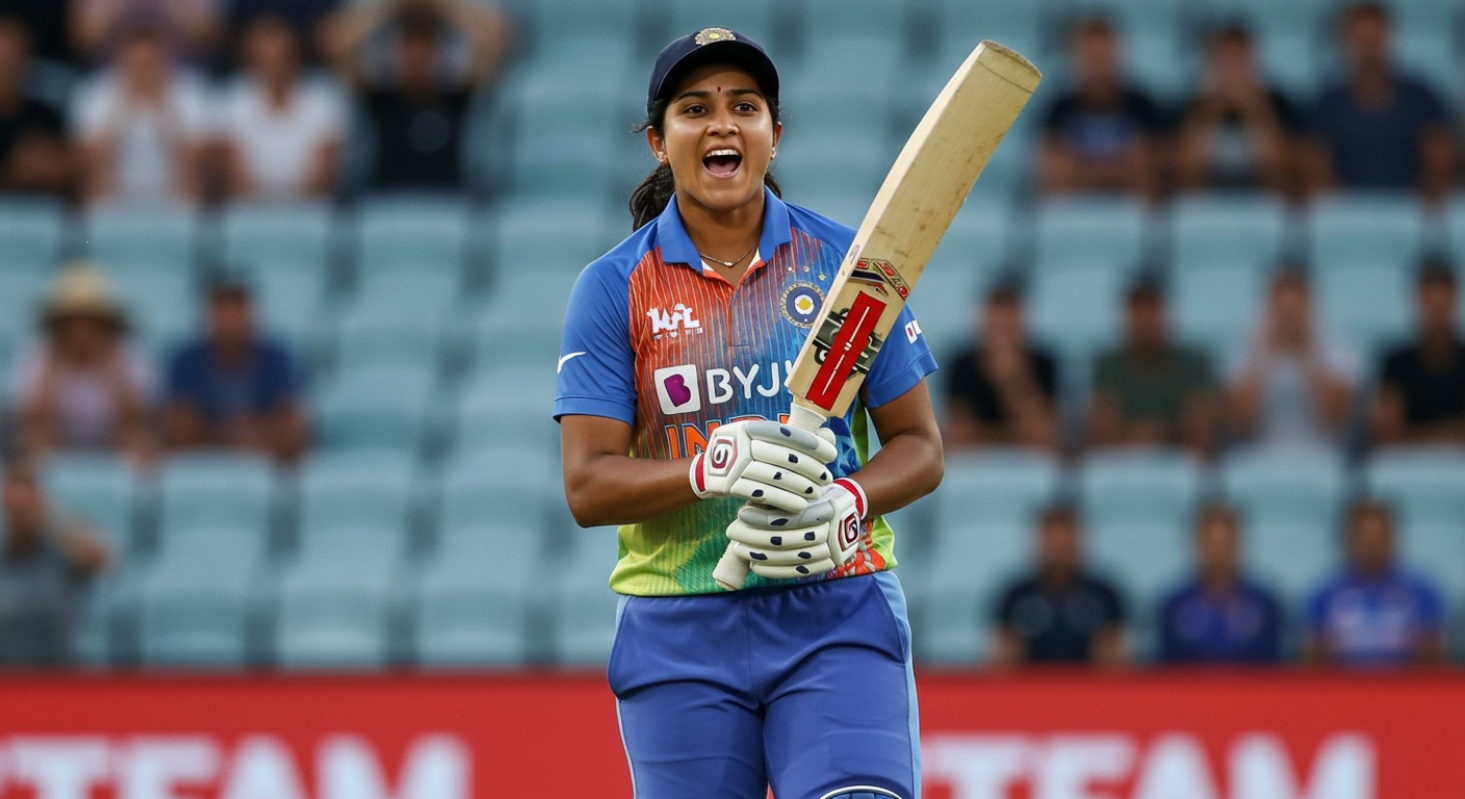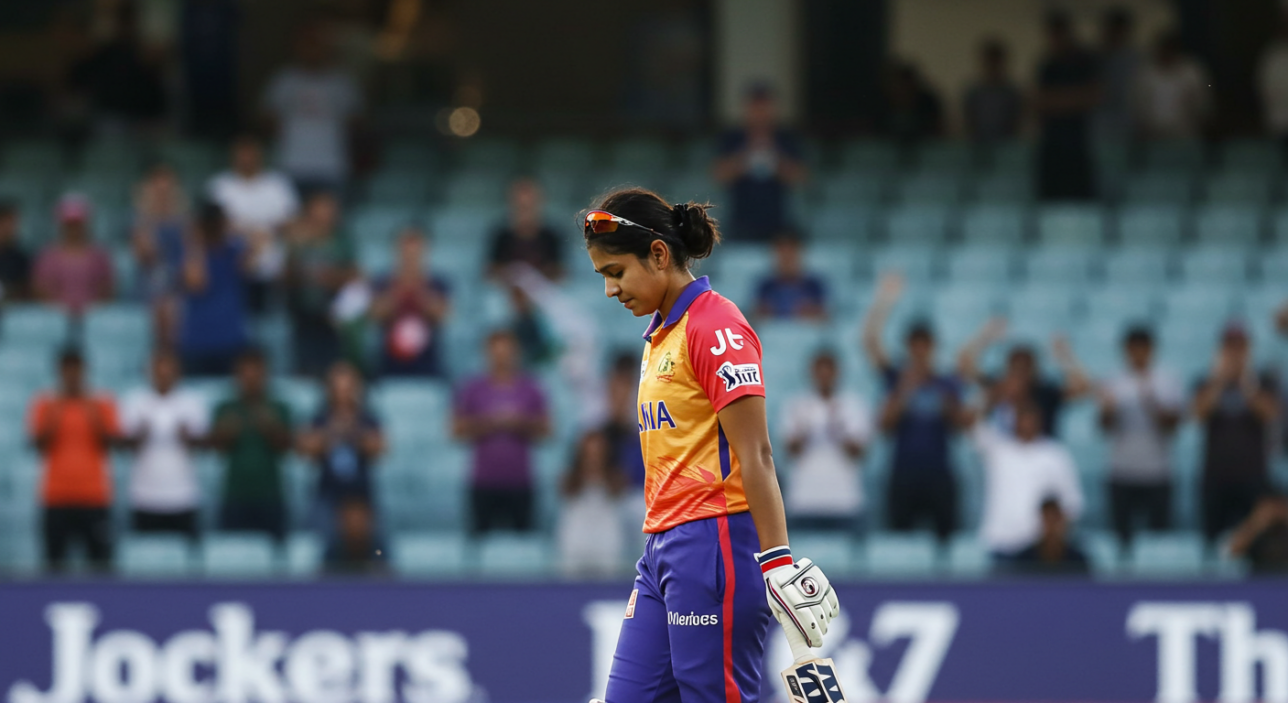
Smriti Mandhana: India’s Batting Star Lighting Up World Cricket
In a game where image and impact are increasingly intertwined, Smriti Mandhana has emerged as a rare figure—someone whose elegance at the crease has never come at the cost of effectiveness. She is not just a technically gifted opener or a visually pleasing stroke-maker. She is a batter who carries the expectations of a cricketing nation every time she walks out to the middle, and more often than not, she does so with the kind of grace that belies the pressure surrounding her.
India’s women’s team has, over the last decade, transformed from an underfunded afterthought into a global force. That transition has required both structural change and standout individuals. Mandhana has become one of the central pillars of that change—not by being loud or aggressive, but by being consistently brilliant, composed under scrutiny, and relentlessly committed to her craft.
Her cover drive has become iconic. Her footwork against pace is swift, yet measured. Against spin, she rarely looks rushed. But what makes Mandhana more than a highlight-reel batter is her adaptability across formats, her ability to recalibrate during an innings, and her habit of delivering runs in difficult situations. She does not chase the extraordinary. She makes the difficult look familiar.
This is not about her popularity or endorsements, though both are substantial. It is about the cricketer behind the icon—the one whose strokeplay inspires admiration, whose temperament provides stability, and whose presence at the top of India’s order has become one of the most dependable constants in the modern game.
A Left-Hander Built for Timing, Not Tinkering

Smriti Mandhana’s batting feels almost out of time. In an era increasingly defined by innovation—reverse sweeps, ramps, and slogged boundaries—her game is a study in classical mechanics. She scores not because she surprises the bowler, but because her basics are refined to such a degree that she rarely needs to. Her strength lies in her ability to anticipate, to shift weight early, and to meet the ball with a full face of the bat more often than not. It is not flashy. But it is incredibly hard to counter.
Her cover drive, often singled out as her trademark, is far more than a flourish. It is a result of balance, head position, and years of repetition. What appears effortless is actually meticulously built. And while that aesthetic appeal often draws attention, it is her shot selection that defines her innings. She rarely plays outside her zone in the first ten balls. She chooses targets, not risks. When she accelerates, she does so through gaps, not gambles.
This measured style is not born of conservatism. It is born of clarity. Mandhana knows her strengths—particularly square on the off side and down the ground against pace—and structures her innings to give those strengths the best chance to flourish. She is not immune to lapses in form, but even in those phases, she doesn’t abandon her method. She may adapt tempo, but her shape rarely falls apart. That stability has made her the preferred opener across formats and a trusted anchor when others look to attack.
From her early days in the India side, when she made her mark with a century in only her second ODI, to her recent exploits in global leagues, what has remained constant is her rhythm. She does not chase momentum. She creates it slowly, over spells, over phases of a game. And while others around her may thrive on aggression, she thrives on control, placement, and the kind of timing that turns good bowling into bad fielding decisions.
Smriti Mandhana’s appeal as a batter goes far beyond her shot selection or her elegance at the crease. She has become the structural anchor of India’s batting line-up—a player whose presence at the top of the order allows others to bat around her with freedom, aggression, or caution as needed. In white-ball cricket especially, she is the platform. And the way she constructs an innings—fluidly in ODIs, more aggressively in T20s—has made her India’s most bankable top-order presence over the past five years.
The Engine of India’s Modern Batting Line-Up
Her ODI record reflects that consistency. Since her debut, she has scored over 3,000 runs at an average that sits comfortably above most of her contemporaries, often setting up or seeing through chases with a methodical calm. She adjusts according to the demands of the moment, but rarely lets urgency compromise her technique. Her innings are built around partnerships—she rotates strike with minimal fuss, keeps dot balls low, and always seems to know when to put pressure back on the bowler with a boundary. She is not a defensive opener by nature; she simply knows when to wait.
In T20 cricket, Mandhana has gradually shifted her gears. While her strike rate has never matched the pure power hitters, her value comes from maintaining shape and pressure even when wickets fall around her. She accelerates in stages, often reaching her half-centuries in 35 to 40 balls—not blistering by modern standards, but enough to keep the scoreboard moving while holding the innings together. In big games, particularly in global tournaments, that steadiness becomes more valuable than raw strike rate.
Her record in T20 World Cups underlines this contribution. She often produces runs in tough conditions—slow wickets, high-pressure games—without forcing shots. Her fifty against England in the 2020 semi-final, played on a tricky surface, was one of the few composed innings in a match defined by collapse. That is where her temperament begins to separate her from peers. She does not allow match context to overwhelm her technique. Instead, she narrows her focus, trusts her zones, and keeps scoring at a tempo that rarely invites risk.
This composure has made her a central figure in India’s plans across formats. Regardless of who opens with her—whether it is Shafali Verma in T20s or Yastika Bhatia in ODIs—Mandhana remains the adaptable half of the pair. She doesn’t dominate partnerships with big strokes. She sets their tone with footwork, positioning, and shot choice. And when she departs early, it often leaves a void that no amount of late hitting can fully compensate for.
A Global Star in a Growing Marketplace

The evolution of women’s cricket into a globally commercial sport has required more than just great performances—it has required players who can carry a game’s narrative beyond the boundary rope. Smriti Mandhana has emerged as that figure not through self-promotion, but through consistency, composure, and a presence that resonates with audiences across cultures. Her impact is not limited to India’s fanbase. She has become a familiar face in Australia’s WBBL, England’s The Hundred, and the Women’s Premier League in India—not just as a marquee player, but as a reliable contributor who lifts team standards and attracts new followers.
Franchise cricket has showcased a different layer of her game. In league settings, where travel is constant, dressing rooms are diverse, and players often have to adapt quickly to unfamiliar roles, Mandhana has thrived. She does not bring theatrics to her performances. She brings fluency. That’s part of why teams value her so highly. She provides structure at the top, performs under lights or in daylight, and rarely lets conditions dictate her method. She is comfortable scoring in Sydney as much as in Surat. That cross-continental reliability has elevated her profile—and, more importantly, the value placed on top-order stability in women’s T20 sides.
Her time with the Southern Brave in The Hundred was a particular turning point in her international image. Against swing, spin, and short-pitched pace, she kept scoring runs in a format designed for fast errors and quick collapse. That is her edge: she rarely panics. She is not immune to failure, but she rarely compounds it. When others rush, she restores tempo.
The same applies to her captaincy stint with the Royal Challengers Bangalore in the WPL. Though the side did not reach the playoffs, Mandhana’s handling of young players, her media responsibility, and her steadiness amid a fluctuating campaign revealed more than her numbers did. She may not seek out leadership roles, but when handed one, she inhabits it with the same clarity she brings to her batting.
Evolving Technique, Unchanging Temperament
At first glance, Smriti Mandhana’s game appears unchanged over the years—built on timing, balance, and textbook precision. But beneath the surface, her technique has undergone steady, thoughtful refinement. She has not abandoned her strengths, but has made them more adaptable. Her bat swing is marginally faster now. Her trigger movement against pace has become more compact. Against spin, particularly on subcontinental tracks, she uses the depth of the crease with far greater control than she did in her early years.
This evolution is not dramatic. It’s quiet. It reflects a player who reviews failure with honesty, not panic. When bowlers found her vulnerable to deliveries angling in from around the wicket, she adjusted her alignment. When teams dried up her off-side scoring, she expanded her range behind square. These are small corrections, rarely noticed in real time, but they have made her more durable against varied attacks and conditions. The footwork remains elegant, but now it’s more purposeful. The cover drive is still her signature, but the inside-out lofted shot over extra cover—once rarely attempted—is now a reliable option.
Importantly, Mandhana has achieved this growth without losing the clarity that defines her presence at the crease. She does not rush. She does not chase. Her rhythm belongs to her, not the scoreboard. Even when out of form, she rarely looks erratic. That mental consistency has made her one of India’s most resilient performers in away series, particularly in Australia and New Zealand, where conditions can easily expose technical flaws and undermine confidence. Her batting in the 2021 multi-format series against Australia was an example of resilience with restraint—her hundred in the pink-ball Test was patient, crafted with minimal risks, and filled with shots played entirely within her comfort zone.
That innings, played under lights on unfamiliar turf, was a statement of maturity more than audacity. It showed she could bat long, bat smart, and build innings even when boundaries didn’t flow. It also confirmed her ability to be the innings’ spine, even in a format where she isn’t widely recognised. That adaptability matters, because it reflects her growth not just as a T20 opener, but as a complete batter.
Consistency Amid a Shifting Indian Side

In recent years, the Indian women’s team has undergone a period of transition. New players have come in with flair. There has been more experimentation at the top, more shuffling in the middle, and a stronger push towards strike rates and dynamism in T20 cricket. Amid these shifts, Smriti Mandhana has remained a fixed point—not because she is the flashiest player in the side, but because she brings something the team cannot afford to do without: reliability.
When others play around her, they play with freedom. When she goes early, the entire batting plan often feels less certain. That kind of centrality is not easy to carry, particularly when the team is learning to recalibrate in the post-Mithali and post-Jhulan era. But Mandhana rarely lets that burden show. She continues to approach her innings with composure, even when surrounded by players with louder styles or more erratic scoring patterns.
Her role has also evolved to include more leadership—formally in some franchises, informally in the national side. She is often the one asked to speak on behalf of the team. She is the one fielding questions after tough losses and answering for performances that were not entirely her own. That presence—stable, thoughtful, self-aware—adds to her value even when she hasn’t scored runs in a match.
This kind of influence is harder to measure than batting averages. It shows up in how she communicates with younger openers, how she adjusts her game when conditions demand it, and how she navigates form slumps with calm rather than denial. In a side searching for its identity in high-stakes tournaments, Mandhana’s game becomes more than just technique. It becomes a source of equilibrium.
Her role is not just to accumulate runs. It is to hold together a batting order that often swings between brilliance and collapse. And over the last five years, she has done that not with declarations, but with presence—quiet, composed, and increasingly irreplaceable.
A Modern Icon, on Her Own Terms
Smriti Mandhana’s stature in world cricket today extends far beyond her cover drive or her ranking among leading run-scorers. She represents something larger—a vision of what a modern Indian cricketer can be without having to mirror anyone else’s style. In a country where comparisons are inevitable and expectations often smother individuality, Mandhana has established a model based on elegance, discipline, and a refusal to abandon her natural rhythm in pursuit of short-term validation.
Her brand of cricket stands in contrast to the hyper-aggressive, power-focused batting that dominates much of the current T20 narrative. But it doesn’t feel out of place. Instead, it offers something else—an assurance that scoring at pace and playing with refinement are not mutually exclusive. Her ability to find gaps, run hard, and keep pressure on the fielding side without slogging is a skill that often goes underappreciated in franchise cricket, but remains invaluable in bilateral series and ICC tournaments.
Her growing presence in global leagues—whether as captain, marquee overseas signing, or the dependable opener—is also helping shift perceptions about Indian players abroad. She brings a sense of professionalism and humility that reflects well not only on herself but on the systems that shaped her. And despite her visibility, she remains unmanufactured. Her media presence is calm. Her public image is consistent. She has become a face of Indian women’s cricket without ever appearing to chase the spotlight.
This composure, both on and off the field, has made her an ambassador of the sport in ways that few others have managed. She is not just admired by fans—she is respected by teammates, trusted by coaches, and recognised by opponents as someone who rarely gives away her wicket cheaply, either in temperament or performance.
Smriti Mandhana: Quiet Fire, Enduring Form

Smriti Mandhana’s rise has been steady rather than spectacular. It has not relied on sudden leaps or reinvention, but on a deep understanding of her strengths and an unshakeable commitment to the way she plays. In a game often driven by extremes—strike rates, milestones, attention—she has offered something more sustainable: a style of batting built on control, rhythm, and clarity of intent.
She is not a cricketer who courts volatility. Her innings, even the aggressive ones, carry the sense that she knows where every shot fits in the larger story of the match. And that awareness, more than any single number, is what has made her central to India’s strategy in all formats. While others burst through the ranks and then fade under scrutiny, Mandhana has stayed relevant by being repeatable, not predictable; stylish, but not soft.
Her role in India’s rise on the global stage cannot be reduced to runs alone. She has helped define the tone of the batting line-up, the expectations of fans, and the shape of professionalism in the women’s game. As younger players rise and the sport accelerates into new leagues and formats, she remains the point of balance—a batter who doesn’t just light up a session, but gives it structure.
Smriti Mandhana is not just an opener. She is a reminder that excellence, when built patiently and lived consistently, doesn’t need to shout to be seen. It simply arrives, over and over again, at the top of the order.





